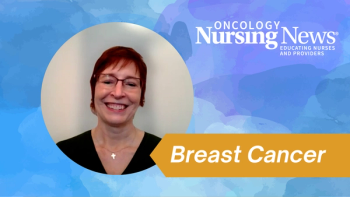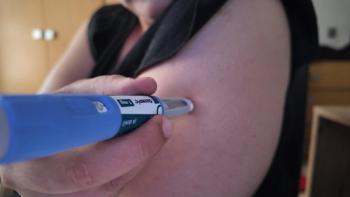
NSCLC Survivors Highlight Unmet Needs in Long-Term Experiences With Immunotherapy
A study presented at the 2022 World Conference on Lung Cancer explored the experiences of patients who received checkpoint inhibition therapy for non–small cell lung cancer.
Survival rates for patients with lung cancer have improved significantly since the advent of immunotherapy, according to Michelle M. Turner, MS, CRNP. However, because of these new advances, there is now a growing population of survivors whose long-term care needs are not well understood.
Because of improvements in lung cancer screening, and developments in targeted and immunotherapies, approximately 20% of patients with lung cancer are expected to survive at least 5 years past diagnosis and the number of survivors is expected to continue to grow by 60,000 individuals annually.
In a presentation at the
“We have really changed the trajectory of our patient’s overall survival, but we don’t know how to take care of them quite as well as we did prior,” Turner said, adding, “little is known about the longitudinal physical, emotional, and financial needs of this population.”
The study involved interviewing patients with pathologically confirmed, locally advanced or metastatic NSCLC who had undergone treatment with immune-checkpoint inhibitors and had survived their first year on this therapy. The interviews were conducted both in-person and over the telephone. A retrospective chart review was used to gather demographic information.
Interviews were transcribed and thematic analysis were performed using a constant comparative methodology to refine themes into a finalized coding scheme. The results included interviews from 10 patients who were NSCLC survivors. Four of these patients were men and 6 were women. Age at time of diagnosis ranged from 63 to 72 years. Eight patients were Caucasian, 1 was African American, and 2 were Mediterranean. Six patients had metastatic disease, 3 had metastatic recurrence, and 1 had locally advanced disease.
Turner acknowledged that there are multiple definitions of survivorship; however, the one she prefers and the one which guided this research is the American Society of Clinical Oncology definition: “The time period between a new [diagnosis of] cancer, followed by the duration of life during and after cancer therapy.”
One of the most prominent themes which many patients echoed was an inability to recall their treatment education. Because lung cancer is associated with a poor prognosis, patients responded that they felt too overwhelmed to process what their providers were attempting to teach them about immunotherapy.
One example of a response from a patient said: “[My physician] explained this immunotherapy and what it was, and I had no idea what she was talking about to be honest with you.”
“We really have to be cognizant when we’re talking to our patients, about our treatments, and that they really understand what is going on,” Turner said.
Similarly, many patients expressed a sense of acceptance of death along with their diagnosis. Some patients reported having paid for their funeral and their house and making other end-of-life preparations. At the same time, for many, news of their diagnosis brought a sense of risk taking and courage: patients were willing to try the unknown, such as experimental treatments, because they equated this with not giving up, even if they were facing potentially severe adverse event (AE) profiles.
In terms of emotional toxicity, guilt and worry were 2 feelings which taxed patient functions and socialization. Although these emotions reportedly waxed and waned throughout the cancer journey, they were described to be long-term toxicities which affected them beyond treatment.
“Occasionally… I’m asked to talk with someone who has cancer,” said one patient. “Sometimes I feel a little bad about it, because certainly I can listen to them, I can offer them hope, but I can’t offer them the kind of miracle that I had. I know that no matter how encouraging I am, the statistical odds are that they won’t be quite as fortunate as I’ve been.”
Another theme which emerged was the sources of support and strength. Participants named numerous sources from which they gain strength, including internal factors such as spirituality, self-reliance, and exercise, and external factors such as family and friends.
“I don’t think I could have had sch a positive outlook without my family around,” one patient shared. “I had a sister that watched me like a baby. And a husband who did the same… I just had a lot of support… I don’t know how people do this without other people.”
In a similar vein, results showed that many of the physical toxicities experience by patients took a toll on their social and emotional well-being. For example, many patients experienced issues with intimacy following sexual dysfunction, and some patients shared that they were afraid to go out in public because of gastrointestinal issues.
“We don’t [necessarily] realize how challenging that is,” Turner said. She shared that many patients may feel as though these complications are simply the price to pay for survivorship, but she disagrees. “[They will say]: Well, I should be happy, I’m alive. And while that’s important, their quality of life is also important,” she said.
Other physical toxicities in later survivorship include generalized fatigue, respiratory issues, dermatologic, neurologic, and endocrine issues, as these all play a role in quality of life, Turner said.
Financial concerns represented another major theme. The main stressors associated with financial concerns for patients included out of pocket costs, the role of insurance, and unemployment throughout cancer care.
One patient shared that they had to empty their IRA to pay for their treatments: their cyberknife laser therapy was $28,000 without treatment, and in total, they owed over $320,000 in hospital bills, but they have since stopped paying attention to what they owe.
“[When considering] all of these toxicities that these patients are experiencing, [ask] are these emotional challenges?” Turner said. “How do they get back into the workforce if they’ve taken time off? We have to support them in different ways.”
Finally, surveillance represented a significant unanswered question for many NSCLC survivors. Many participants noted that they went to a primary care provider for longitudinal follow-up care but were unsure whether these generalists would be able to properly address their specific needs—particularly long-term immunotherapy symptoms.
“We have a lot of work to do,” Turner summarized, stating that identifying the physical, social, emotional, and medical needs of patients 5 years beyond treatment remains a challenge for providers.
“Survivorship programs have to be personalized based on our institution, based on our provider-patient relationship, to see what the needs of our patients and support services in place are,” she concluded. “This is not a one man show: we have to get engage social work, psychiatry, clergy, financial counselors, palliative care, the list goes on. [Although] it’s important to take care of their medical needs, there is a whole different level we have to focus on as well.”
Reference
Turner MM. Long-term immunotherapy survivors of advanced NSCLC: the survivorship experience. Presented at the 2022 World Conference on Lung Cancer; August 6-9, 2022; Vienna, Austria. Abstract ES31.03
Newsletter
Knowledge is power. Don’t miss the most recent breakthroughs in cancer care.






























































































